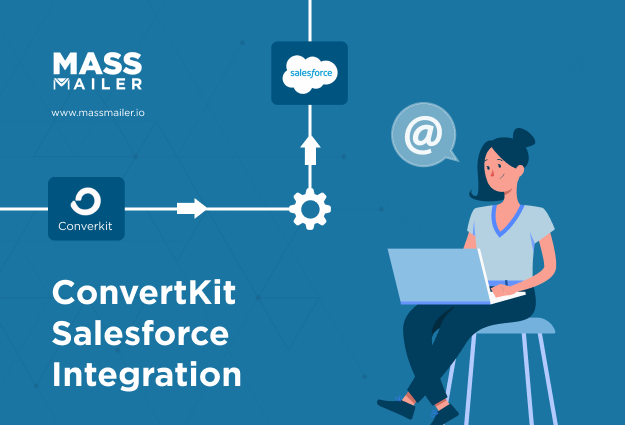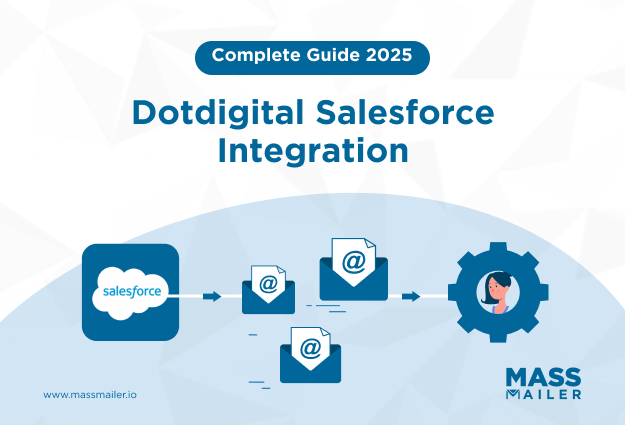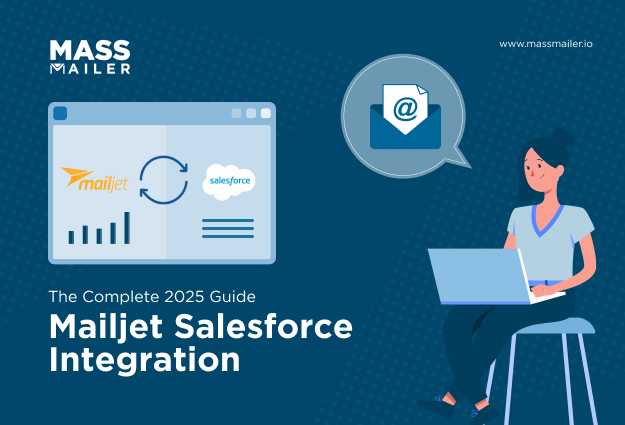Table of Contents
Introduction
According to a Salesforce survey, 93% of people stated that email was their primary channel for engaging with companies. It underscores the significance of email as a direct communication tool, fostering engagement and conversions across industries.
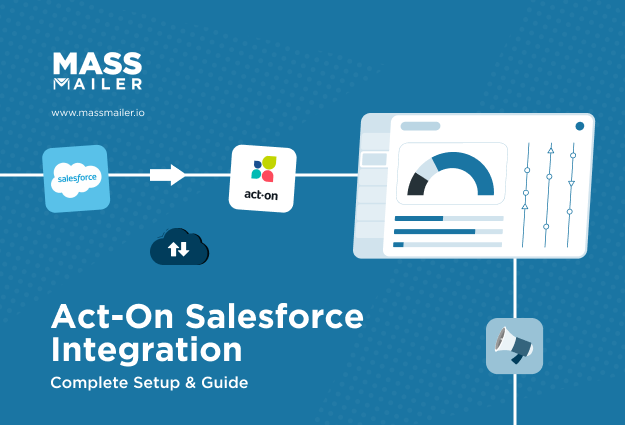
To leverage this powerful channel effectively, businesses turn to email marketing tools. These tools allow marketers to create personalized campaigns, track engagement, and optimize messaging. However, as marketing strategies evolve, marketers need more than just email.
Automation tools streamline complex workflows, enabling teams to deliver the right message to the right audience at the right time, all while saving valuable time and resources.
If you are already an Act-On user, it is one of the most effective solutions for integrating email marketing with automation. It is a robust marketing tool designed to provide a comprehensive platform for managing campaigns, customer engagement, and analytics.
But to truly unlock its full potential, integrations are crucial, especially with platforms like Salesforce (which is a source of truth for a lot of organizations).
In this blog, we’ll dive deep into Act-On Salesforce integration, explore alternative connectors for connecting Act-On with Salesforce, and look into Act-On alternatives for businesses seeking different solutions for marketing automation and CRM syncing.
What is Act-On Salesforce integration?
Act-On Salesforce integration connects the Act-On marketing automation platform with Salesforce CRM, enabling seamless data synchronization between marketing and sales teams. This integration allows marketers to automatically push leads, contacts, and campaign metrics into Salesforce, while providing sales teams with insights into customer behavior, such as email opens, clicks, and form submissions.
By syncing data in real-time, Act-On and Salesforce create a unified view of customer engagement, helping sales teams prioritize leads more effectively and enabling marketers to track ROI directly within Salesforce. This integration streamlines workflows, improves lead management, and enhances alignment between marketing and sales.
Step-by-step process to integrate Act-On with Salesforce
The following step-by-step process will help you set up the Act-on Salesforce integration correctly from the start, reduce sync issues later, and ensure every engagement, lead score, and campaign metric flows where it’s needed.
Each step builds on the previous one, moving from system readiness to data validation, so you can establish a stable, scalable connection that both marketing and sales can trust.
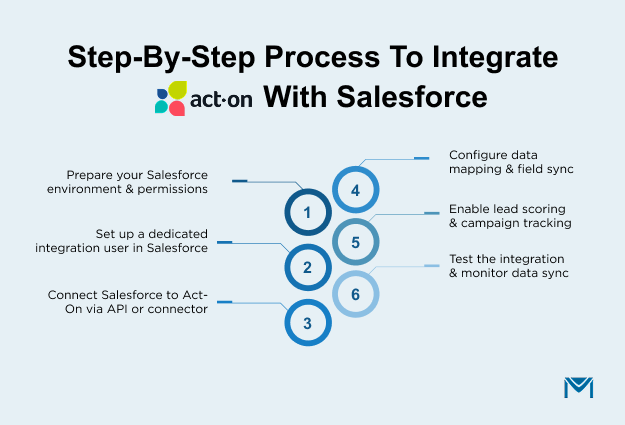
Step 1: Prepare your Salesforce environment and permissions
Confirm that your Salesforce edition includes API access and that you have system administrator rights in both Salesforce and Act-On. Create a short readiness checklist that covers object permissions for Leads, Contacts, Accounts, Campaigns, and Campaign Members, plus field-level security for any custom fields you plan to map, such as Lead Score or Lifecycle Stage.
Verify that “API Enabled” is assigned through a profile or permission set and that IP restrictions or login hours will not block the connector. If you operate multiple record types, decide which ones should sync to Act-On and document list views or criteria to filter them.
Enable field history tracking on core attribution fields so you can audit changes after the first sync. If your org uses Person Accounts, confirm how those records will appear in Act-On before you proceed, since field availability and mapping differ from standard Contacts.
Common pain points at this stage include hidden read-only fields that silently block updates, unmanaged picklist values that fail validation during sync, and duplicate rules that create “save failed” errors. Resolve these in the sandbox first, then repeat in production to avoid mid-project rework.
Step 2: Set up a dedicated integration user in Salesforce
Create a user specifically for the Act-On connector. Assign a minimal but complete permission set that includes API access, read and edit on Leads, Contacts, Campaigns, and Campaign Members, and access to any custom objects you will reference.
Exclude MFA policies that would interrupt programmatic logins and place the user in a non-expiring password policy if your security model allows it. Store the security token in a secure password manager and restrict access to a small group.
This approach isolates credentials from employee turnover and reduces the chance of the integration breaking during routine password resets. It also centralizes audit trails so you can trace all connector-initiated updates to a single user.
Teams that skip this step often experience recurring authentication failures and fragmented troubleshooting, especially when several admins share personal credentials.
Step 3: Connect Salesforce to Act-On via API or connector
In Act-On, open Settings, choose Connectors, select CRM, and pick Salesforce. Authenticate with the integration user. If required, append the security token to the password when logging in.
On successful connection, Act-On exposes configuration screens for objects, sync direction, and mapping. If your security team enforces login IP ranges, add Act-On’s IPs in Salesforce to avoid blocked sessions. For multi-org companies, label the connection with the Salesforce org name so future admins recognize which environment is linked.
Before saving, plan the first incremental sync scope. Start with a small, high-quality segment such as active leads with recent engagement. This limits noise in early testing and makes failures easier to diagnose. Capture screenshots of each connector screen so you can reproduce settings later or include them in change control.
Step 4: Configure data mapping and field sync
Map the Salesforce fields that sellers actually use to qualify and prioritize work. Typical mappings include Lead Source, Lead Status, Lifecycle Stage, Owner ID, Account, Campaign, and score or grading fields from Act-On. Align data types and lengths to prevent truncation. For picklists, ensure values match in both systems to avoid validation errors.
- Decide the sync direction for each field.
- Contact details often flow both ways, while ownership and system timestamps should remain Salesforce authoritative.
- Map opt-out and bounce flags correctly, since these govern compliance and deliverability.
- Confirm that Campaign Member status values align with the values in your Salesforce Campaigns to preserve reporting.
Create a field mapping register that lists the purpose, data type, allowed values, and sync direction for every mapped field. Keep this document with your CRM schema standards. Without this artifact, teams tend to add ad-hoc fields over time and create conflicting sources of truth that are hard to unwind.
Step 5: Enable lead scoring and campaign tracking
Turn on Act-On lead scoring and define a rubric that mirrors how your sales team prioritizes outreach. Assign points for actions that show buying intent, such as pricing page views or high-value content downloads, and reduce points for low-intent activity such as repeat homepage visits.
Send score and recent activity summaries to Salesforce so reps see context on the record layout. Enable campaign tracking so email, form, and landing page responses write to Campaign Members or related engagement fields.
Place these insights on the Lead or Contact page using Salesforce-related lists and compact layouts so reps do not need to search for them.
The practical win here is faster qualification. Reps who see last touch, score, and recent actions in one place make better decisions about callbacks and sequences. Marketing gets cleaner feedback on which programs are influencing the pipeline because Campaign Members carry consistent statuses and timestamps.
Step 6: Test the integration and monitor data sync
Begin with a controlled test that includes a handful of Leads and Contacts. Update a few mapped fields in both systems and verify that values land correctly with the expected direction and timestamps. Convert one test Lead to a Contact and confirm the connector behavior after conversion.
- Check how opt-out and bounce fields carry over during the next sync.
- Review the integration logs for errors and categorize them into authentication issues, permissions, mapping mismatches, and data validation problems.
- Address one category at a time to keep testing focused.
Set a sync schedule that matches your sales rhythm. High-velocity teams prefer frequent or near real-time updates for score and activity fields, while lower-volume motions may run on scheduled hourly or daily jobs.
Establish basic observability by tracking sync success rate, average latency from activity to visibility in Salesforce, and the count of failed records by root cause. When you are ready to expand customer analytics beyond CRM, note that Salesforce Data Cloud lists an Act-On connector in beta that can ingest Act-On data for unified profiles and segmentation in a CDP model.
Evaluate this only after the core CRM integration is stable, since it introduces additional mappings, identities, and governance needs.
Alternative ways to integrate Act-On with Salesforce
While the native Act-On Salesforce integration connector provides a seamless and reliable solution for most use cases, there are scenarios where alternative approaches may offer more flexibility, advanced features, or faster implementation.
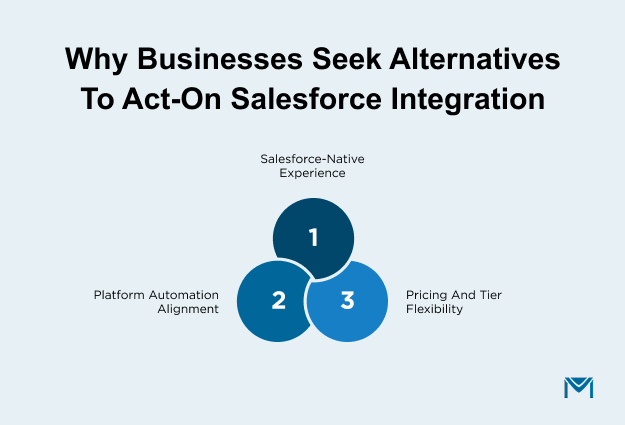
Connecting via Middleware Platforms like Zapier, Cazoomi, or Tray.io
When time is of the essence and you need to get the integration up and running quickly, iPaaS (Integration Platform as a Service) tools like Zapier, Cazoomi, and Tray.io provide a no-code or low-code solution that connects Act-On and Salesforce with minimal technical complexity.
These platforms allow users to create automations that pass data between Act-On and Salesforce in minutes, making them ideal for small businesses, agile marketing teams, or short-term integrations where quick time-to-value is essential.
Why Choose Middleware Solutions?
- Quick Deployment: For teams that need to avoid the heavy lifting of custom coding or configuration, these platforms offer pre-built templates that help integrate Act-On and Salesforce without a dedicated developer. For example, Zapier’s “zaps” automatically trigger actions like adding contacts from Act-On to Salesforce based on campaign responses or other engagement metrics. This allows marketers to quickly deploy a solution and start syncing data, with minimal downtime or delay.
- No-Code Flexibility: With platforms like Zapier or Tray.io, you don’t need advanced programming skills to create customized workflows. This is particularly valuable for marketing teams that are focused on quick automation without needing the full engineering overhead that comes with API work.
Limitations to Consider
While middleware platforms offer great convenience, they are best suited for simpler integrations. More complex needs, such as bidirectional opt-outs, custom field mappings, and real-time synchronization, can push these platforms to their limits.
For example, Zapier excels at connecting specific data triggers between Act-On and Salesforce but may struggle with handling large datasets or complex custom field mappings that require intricate field-level control.
Cazoomi SyncApps offers a more robust solution for organizations that require advanced features like handling Campaign Members, syncing with Person Accounts, or segmentation in Salesforce.
SyncApps is more advanced in that it provides bidirectional data syncing with comprehensive object-level mapping and more granular control over the synchronization of Salesforce Campaigns and Act-On lists, making it suitable for enterprise-level needs. However, this comes at a higher price point compared to simpler middleware tools like Zapier.
Custom Integration Using Salesforce API and Act-On API
For businesses with more complex needs, where off-the-shelf solutions don’t fully address their requirements, a custom integration using the Salesforce REST API and Act-On APIs offers the highest level of control and flexibility.
This approach allows for granular customization, such as data transformations, advanced automation logic, and integrating Act-On with other systems beyond Salesforce.
Why Choose a Custom API Integration?
- Complex Data Models: If your business has a custom Salesforce setup with unique objects, fields, or processes, the native Act-On connector may not capture everything you need. Custom API integrations give you full control over how data is transferred and transformed between systems.
- Enforce Data Governance and Deduplication: Many businesses require strict rules around data quality, like ensuring that no duplicate leads or contacts are entered into Salesforce from Act-On. With a custom API integration, you can implement deduplication rules and enforce field normalization directly in the integration logic, ensuring only clean data flows through.
- Multi-System Integration: Custom APIs also allow you to integrate Act-On and Salesforce with other internal tools like data lakes, analytics platforms, or custom CRMs. For example, a business might push engagement data from Act-On to a data lake, where data is processed and enriched before being sent back to Salesforce.
Limitations to Consider
- Technical Expertise Required: Developing a custom API integration requires strong technical skills, especially in handling API calls, authentication, error handling, and data transformations. This is not a no-code solution and may require the involvement of a Salesforce developer or external consultancy.
- Increased Maintenance: With custom APIs, you will need to regularly maintain and update the integration, especially as Salesforce and Act-On evolve over time. API versions change, data models shift, and new features are added, which means your integration will need ongoing adjustments to remain functional.
When to Choose a Third-Party Integration Over the Native Connector
Choosing a third-party integration over the native Act-On Salesforce connector is a decision that depends on specific needs that the standard connector might not be able to meet. For businesses with complex workflows, multiple apps in their tech stack, or strict data governance requirements, third-party tools can offer more flexibility and control.
Why Choose a Third-Party Integration?
- Multi-Platform Coordination: If you need to connect Salesforce and Act-On with several other systems (like a marketing analytics platform, ERP, or custom CRM), third-party platforms like Zapier, Cazoomi SyncApps, and Tray.io provide sophisticated logic to link multiple tools together in one workflow. This approach is especially useful when you want to cross-sync data between systems based on behaviors or actions (e.g., adding/removing Campaign Members based on email engagement).
- Sophisticated Error Handling: Many third-party tools provide advanced error monitoring and retry logic, ensuring that data flows smoothly even when temporary issues occur. For example, SyncApps offers detailed logging features and the ability to retry failed records, a vital function when syncing large volumes of data with strict SLAs.
- Cross-Object Logic: If your integration requires more than simple data syncing (such as adding Campaign Members based on behavioral thresholds or creating new objects in Salesforce based on specific Act-On activity), middleware tools like Cazoomi SyncApps allow you to build these complex workflows.
Limitations to Consider
Third-party integrations are not a one-size-fits-all solution. They are best used when the native connector can’t meet your unique requirements. For example, while Zapier offers simplicity for small-scale automations, it may not handle large volumes of data as efficiently as Cazoomi SyncApps. Likewise, while SyncApps provides great functionality, it might be overkill for teams with less complex integration needs.
The key is understanding the level of complexity in your workflows, the volume of data, and the need for real-time syncing, so you can choose the right approach to maximize the benefits of marketing and CRM alignment.
Common challenges with Act-On Salesforce integration
Below, we explore the most common challenges teams face with Act-On Salesforce integration, along with actionable solutions and insights to resolve them.
Data Sync Delays or Failures Between Act-On and Salesforce
Data synchronization delays are one of the most frequently encountered problems when integrating Act-On with Salesforce. These delays are typically caused by a combination of API rate limits, large data batch sizes, or expired credentials.
Salesforce’s API has daily rate limits, meaning that if you’re processing a large volume of records, you may hit these limits, causing sync failures or delays. Similarly, large batches of data can overwhelm the integration, resulting in slower updates or failed transfers.
Common Causes:
- API Rate Limits: Salesforce imposes a limit on the number of API calls that can be made in a 24-hour period. If you’re syncing large volumes of data, you may quickly reach this limit.
- Large Batch Sizes: Transferring too many records at once can result in timeouts or incomplete data transfers.
- Expired Credentials: Tokens or passwords associated with the integration user may expire, causing the integration to fail without warning.
As Salesforce users know, managing API calls and ensuring smooth data synchronization can be a headache. A user recently shared their frustrations about hitting API rate limits, causing delays in crucial business integrations.
They explained that their Salesforce org, with an API limit of 180,000 calls per day, often hits this cap unexpectedly, which stalls other essential processes. Despite trying to monitor API usage through Salesforce’s “API Calls Made Within the Last 7 Days” report, they found it insufficient and difficult to pinpoint the source of the excessive calls.
As data grows and integrations expand, hitting the API limit becomes a serious barrier. These frequent sync delays, whether from large batch sizes or expired credentials, disrupt business-critical processes, making it difficult to maintain efficient workflows across platforms like Act-On and Salesforce.
Field Mapping Errors and Data Mismatch Issues
Another challenge often arises when data doesn’t land where it’s supposed to. This typically happens due to misaligned picklists, read-only fields, or field mismatches between Salesforce and Act-On.
When syncing data, it’s crucial that the field types in both systems match (e.g., text fields in Salesforce should map to text fields in Act-On). If the mapping isn’t aligned, the sync will fail or, worse, lead to inaccurate or missing data.
Common Causes:
- Misaligned Picklists: If the values in Salesforce’s picklist fields don’t match those in Act-On, data won’t be synced properly.
- Read-Only Fields: If Salesforce fields are marked as read-only, they cannot be updated during the sync, leading to incomplete data transfers.
- Name/ID Mismatches: Data discrepancies can occur when field names or IDs differ between systems.
When dealing with Salesforce and Act-On integration, one user shared their frustration with field mapping issues, highlighting the challenges that occur when field types don’t match.
For example, mismatches between Salesforce’s picklist fields and Act-On’s equivalent fields can prevent data from syncing correctly, which ultimately affects lead quality and campaign effectiveness.
Another user mentioned how their picklists weren’t aligning properly between the two platforms, causing data to be either skipped or misclassified. Another shared that they were running into issues with ID mismatches, where Salesforce’s field identifiers didn’t correspond with those in Act-On. This led to missing data and, in some cases, inaccurate records being transferred across systems.
Duplicate Records and Lead Ownership Conflicts
Duplicate records are a persistent problem when both marketing and sales teams are creating and updating data in their respective systems. When records are not de-duplicated during syncs, you end up with multiple instances of the same lead or contact, creating confusion and wasted effort for sales teams who may follow up with the same lead multiple times.
Common Causes:
- Data Entry Inconsistencies: Marketing and sales teams may enter slightly different versions of the same record (e.g., different email addresses or names).
- Lack of Deduplication: Without a proper deduplication strategy in place, Act-On and Salesforce can create multiple records for the same contact or lead, especially when records are updated in one system and not reflected in the other.
- Lead Ownership Conflicts: Sometimes, a lead may be assigned to multiple owners in different systems, creating a conflict.
These challenges are common but manageable with the right processes and tools in place. Whether dealing with data sync delays, field mapping errors, or authentication issues, a thoughtful approach to integration management ensures that both marketing and sales teams are aligned and operating from the same data source.
Alternatives to Act-On Salesforce integration
While Act-On Salesforce integration is a powerful tool for aligning marketing and sales, some organizations may find themselves exploring alternative solutions due to specific needs around compliance, simplicity, or internal preferences.
These alternatives can offer better alignment with Salesforce’s native features, reduce complexity, or provide specialized functionalities that Act-On may not fully address. In this section, we’ll discuss why businesses might seek alternatives and explore some popular options.
Why Businesses Seek Alternatives to Act-On Salesforce Integration
There are several reasons why businesses might consider alternatives to Act-On Salesforce integration. Understanding these motivations can help you assess whether an alternative solution could be a better fit for your organization.
Salesforce-Native Experience
Many businesses, particularly those with high Salesforce adoption, prefer tools that live directly within Salesforce. The reason for this is clear: having a Salesforce-native solution ensures tighter integration, easier access, and more seamless user experiences.
For example, Salesforce-native tools automatically inherit Salesforce’s security protocols, compliance rules, and permission settings, making it easier for businesses to stay compliant with data protection regulations.
This is especially critical as data privacy laws like GDPR, CCPA, and others become stricter. For organizations that prioritize data governance and want to avoid having multiple platforms with different compliance frameworks, native integrations, or fully Salesforce-native tools can help simplify governance.
Platform Automation Alignment
Salesforce is known for its robust automation capabilities. For teams that heavily rely on Salesforce workflows, process builders, or Apex triggers, having a marketing automation solution that integrates seamlessly into this ecosystem can significantly enhance operational efficiency.
By using a Salesforce-native tool, teams can trigger workflows, track leads, and manage campaigns without needing to shift between multiple platforms. This tight alignment with the Salesforce ecosystem reduces the risk of disconnected workflows, providing a more unified approach to automation.
Pricing and Tier Flexibility
Pricing structures can be a significant factor in choosing a marketing automation platform. Act-On offers a comprehensive suite of features, but for some businesses, the cost may be too high, especially if they don’t require the full range of capabilities.
In contrast, Salesforce-native tools like MassMailer can be more cost-effective, especially for organizations that already have a Salesforce subscription. With fewer integration points, fewer external services are required, allowing businesses to reduce costs related to external connectors, support, and training.
MassMailer: A Salesforce-Native Alternative
MassMailer is a leading alternative to Act-On for businesses that want to keep their marketing automation entirely within Salesforce. This tool is designed specifically to leverage Salesforce’s native capabilities, providing email marketing, automation, and tracking without requiring users to leave the Salesforce platform.
MassMailer is especially suited for businesses that prefer to keep all their customer data and processes in one system, reducing the complexity of managing multiple systems and integrations.
Key Features of MassMailer
1. Built Natively on Salesforce
One of MassMailer’s standout features is that it is completely integrated within Salesforce. This means that it directly benefits from all the security, compliance, and governance features that Salesforce provides.
For organizations already operating within the Salesforce ecosystem, this eliminates the need for complex integrations, while also ensuring data privacy and compliance standards are maintained.
2. Security & Compliance
Data stored within Salesforce adheres to Salesforce’s security models, making it easier to maintain compliance with regulatory requirements like GDPR and CCPA. The same role-based access controls (RBAC) used for CRM data can be applied to marketing data, reducing the risk of data leaks or non-compliance.
3. Template Building, Testing, and Personalization Within Salesforce
MassMailer allows users to build and personalize email templates directly within Salesforce. This native integration simplifies the process of creating, testing, and sending email campaigns without needing to switch between separate platforms.
Users can leverage Salesforce’s built-in data models (e.g., Lead, Contact, Account) to personalize messages and create dynamic content blocks, enhancing the relevance of the campaigns.
4. Tracking for Opens, Clicks, and Bounces at Lead, Contact, and Campaign Levels
MassMailer provides real-time tracking of key email metrics such as opens, clicks, and bounces, directly within Salesforce. These metrics are mapped back to Lead and Contact records, giving sales teams full visibility into how engaged their prospects are with marketing content.
5. Automation Through Salesforce Flows/Workflows
MassMailer supports the use of Salesforce Flows and Workflows to automate key processes like lead assignment, follow-up tasks, or sending triggered email campaigns based on specific actions (such as form submissions or email opens). This integration ensures that the marketing automation process is entirely within the Salesforce platform, streamlining operations and reducing the complexity of external tools.
When to Choose MassMailer Over Act-On Salesforce Integration
While Act-On offers extensive functionality for marketers, MassMailer can be a better fit for certain organizations, particularly those that:
- Want to keep everything within Salesforce: If your organization already relies heavily on Salesforce and you’re looking to avoid managing separate platforms for email marketing, MassMailer is the perfect alternative. It integrates smoothly with Salesforce without introducing the complexity of external connectors or additional platforms.
- Need a simple, cost-effective solution: MassMailer can be more affordable for businesses that don’t require all of the advanced features Act-On offers, such as predictive analytics or multi-channel automation. It’s ideal for teams that want a straightforward solution for email marketing and need it to work seamlessly with Salesforce.
- Focus on compliance and data governance: For organizations prioritizing data privacy and governance, MassMailer’s native integration with Salesforce ensures that all customer data remains within Salesforce’s secure environment, reducing the risk associated with moving data across multiple platforms.
MassMailer’s Salesforce-native experience ensures seamless integration, real-time tracking, and automation within the same platform, providing a simpler, more cost-effective solution for businesses with simpler marketing needs or high compliance requirements.
When evaluating marketing automation solutions, it’s important to assess your organization’s needs in terms of data governance, pricing, and platform alignment to choose the best solution for your team.
Conclusion
According to Salesforce, Marketing Cloud delivers a 32% increase in overall marketing ROI and customer engagement. Marketing Cloud offers a comprehensive suite of features, including email marketing, email automation, and an HTML template builder, all designed to streamline campaigns, enhance personalization, and drive conversions.
Salesforce’s ability to integrate with a wide range of third-party tools and platforms allows businesses to build a solution that fits their unique needs. With Salesforce’s flexibility, companies can extend their capabilities, ensuring a seamless flow of data and actions across all their systems.
Act-On’s deep integration with Salesforce enhances lead scoring, automates workflows, and ensures that sales teams have actionable insights directly within their CRM.
For businesses seeking a Salesforce-native experience, MassMailer serves as an excellent alternative to Act-On. With its native integration within Salesforce, MassMailer provides seamless email marketing automation, personalized templates, and robust reporting, all within the Salesforce platform.
Whether you choose Salesforce Marketing Cloud to harness its power, Act-On for deeper integration, or MassMailer for a native Salesforce solution, the key is to leverage the right tools to drive marketing success.
Want to learn more about how MassMailer can improve your email marketing strategy? Book a call with our team today for a personalized demo, and we’ll walk you through how MassMailer can seamlessly integrate into your workflow and help you achieve your marketing goals.
FAQs
1. Is Act-On natively integrated with Salesforce?
Yes. Act-On provides a native connector for Salesforce, which includes a guided setup to connect accounts, synchronize data, and map both standard and custom fields. Full documentation is available in Act-On’s Help Center.
2. How do I integrate Act-On with Salesforce quickly?
For a fast setup, use Act-On’s official connector for a managed, bi-directional sync between platforms. If you need rapid automations and custom triggers, no-code tools like Zapier can help you integrate in minutes.
3. Can I sync custom fields and campaign engagement into Salesforce?
Yes. Act-On allows mapping of both standard and custom fields. Campaign metrics and engagement data can also be surfaced in Salesforce when enabled and permissioned correctly.
3. What should I watch out for regarding tokens and passwords?
Token resets or password changes can break the integration. It’s recommended to use a dedicated integration user and re-authenticate in Act-On promptly after any password or token changes.
5. When does a third-party tool make more sense than the native connector?
Third-party tools or custom API solutions are ideal if you require advanced routing, multi-app logic, or robust error handling. Tools like SyncApps provide broad Salesforce object coverage, while Zapier is suited for quick, no-code workflows


